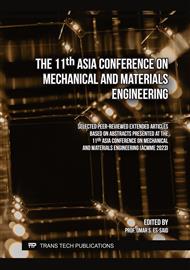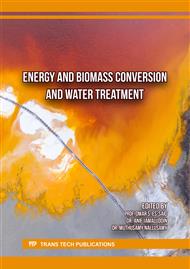[1]
X. Li, L. G. Tabil, and S. Panigrahi, "Chemical treatments of natural fiber for use in natural fiber-reinforced composites: A review," J Polym Environ, vol. 15, no. 1, p.25–33, 2007.
DOI: 10.1007/s10924-006-0042-3
Google Scholar
[2]
J. R. Mohanty, S. N. Das, H. C. Das, and S. K. Swain, "Effect of Chemically Modified Date Palm Leaf Fiber on Mechanical, Thermal and Rheological Properties of Polyvinylpyrrolidone," Fibers and Polymers, vol. 15, no. 5, p.1062–1070, 2014.
DOI: 10.1007/s12221-014-1062-6
Google Scholar
[3]
A. Gopinath, M. Senthil Kumar, and A. Elayaperumal, "Experimental investigations on mechanical properties of jute fiber reinforced composites with polyester and epoxy resin matrices," Procedia Eng, vol. 97, p.2052–2063, 2014.
DOI: 10.1016/j.proeng.2014.12.448
Google Scholar
[4]
B. Haridas, "A Study on Mechanical and Thermal Behavior of Coir Fiber Reinforced Epoxy Composites A Study on Mechanical and Thermal Behavior of Coir Fiber Reinforced Epoxy Composites," no. June, p.45, 2014.
DOI: 10.1002/pc.22736
Google Scholar
[5]
A. Karun, E. A. Siril, E. Radha, and V. A. Parthasarathy, "Somatic embryogenesis and plantlet regeneration from leaf and inflorescence explants of arecanut (Areca catechu L.)," Curr Sci, vol. 86, no. 12, p.1623–1628, 2004.
Google Scholar
[6]
L. Yusriah, S. M. Sapuan, E. S. Zainudin, and M. Mariatti, "Characterization of physical, mechanical, thermal and morphological properties of agro-waste betel nut (Areca catechu) husk fibre," J Clean Prod, vol. 72, p.174–180, 2014.
DOI: 10.1016/j.jclepro.2014.02.025
Google Scholar
[7]
R. B. Ashok, C. v. Srinivasa, and B. Basavaraju, "A review on the mechanical properties of areca fiber reinforced composites," Science and Technology of Materials, 2018.
DOI: 10.1016/j.stmat.2018.05.004
Google Scholar
[8]
L. Yusriah, S. M. Sapuan, E. S. Zainudin, and M. Mariatti, "Exploring the Potential of Betel Nut Husk Fiber as Reinforcement in Polymer Composites: Effect of Fiber Maturity," Procedia Chem, vol. 4, no. June, p.87–94, 2012.
DOI: 10.1016/j.proche.2012.06.013
Google Scholar
[9]
N. Razali, M. S. Salit, M. Jawaid, M. R. Ishak, and Y. Lazim, "A study on chemical composition, physical, tensile, morphological, and thermal properties of roselle fibre: Effect of fibre maturity," Bioresources, vol. 10, no. 1, p.1803–1823, 2015.
DOI: 10.15376/biores.10.1.1803-1824
Google Scholar
[10]
E. Jayamani, S. Hamdan, M. R. Rahman, and M. K. bin Bakri, "Investigation of fiber surface treatment on mechanical, acoustical and thermal properties of betelnut fiber polyester composites," Procedia Eng, vol. 97, p.545–554, 2014.
DOI: 10.1016/j.proeng.2014.12.282
Google Scholar
[11]
G. Chethan, Y. Narayana, and K. C. Sunil, "DEVELOPMENT AND CHARACTERIZATION OF LOW THERMAL CONDUCTIVITY MATERIAL FROM REINFORCED ARECA HUSK FIBER COMPOSITE," vol. 13, no. 3, p.87–100, 2022.
DOI: 10.1615/compmechcomputapplintj.2022043114
Google Scholar
[12]
G. Chethan, K. C. Sunil, S. Achary, and M. Kavasara, "Extraction of Fibers from Unripe , Ripe and Dried Areca Husk of Southern Shimoga Region on the Western Ghats Introduction :," no. c, p.574199, 2015.
Google Scholar
[13]
D. Sampathkumar, R. Punyamurthy, B. Bennehalli, R. P. Ranganagowda, and S. Chikkol Venkateshappa, "NATURAL ARECA FIBER: SURFACE MODIFICATION AND SPECTRAL STUDIES TYPE (METHOD/APPROACH) Spectral studies Council for Innovative Research," Journal: Journal of Advances in Chemistry, vol. 10, no. 10, p.3263–3273, [Online]. Available: www.cirjac.com
DOI: 10.1016/j.matpr.2018.10.042
Google Scholar
[14]
P. E. Imoisili and T. C. Jen, "Mechanical and water absorption behaviour of potassium permanganate (KMnO4) treated plantain (Musa Paradisiacal) fibre/epoxy bio-composites," Journal of Materials Research and Technology, vol. 9, no. 4, p.8705–8713, 2020.
DOI: 10.1016/j.jmrt.2020.05.121
Google Scholar
[15]
S. Nayak and J. R. Mohanty, "Influence of chemical treatment on tensile strength, water absorption, surface morphology, and thermal analysis of areca sheath fibers," Journal of Natural Fibers, vol. 16, no. 4, p.589–599, 2019.
DOI: 10.1080/15440478.2018.1430650
Google Scholar
[16]
S. Dhanalakshmi, P. Ramadevi, and B. Basavaraju, "Areca fiber reinforced epoxy composites: Effect of chemical treatments on impact strength," Oriental Journal of Chemistry, vol. 31, no. 2, p.763–769, 2015.
DOI: 10.13005/ojc/310218
Google Scholar
[17]
M. M. Kabir, H. Wang, K. T. Lau, and F. Cardona, "Chemical treatments on plant-based natural fibre reinforced polymer composites: An overview," Compos B Eng, vol. 43, no. 7, p.2883–2892, 2012.
DOI: 10.1016/j.compositesb.2012.04.053
Google Scholar
[18]
M. Z. Rong, M. Q. Zhang, Y. Liu, G. C. Yang, and H. M. Zeng, "The effect of fiber treatment on the mechanical properties of unidirectional sisal-reinforced epoxy composites," Compos Sci Technol, vol. 61, no. 10, p.1437–1447, 2001.
DOI: 10.1016/S0266-3538(01)00046-X
Google Scholar
[19]
P. Muensri, T. Kunanopparat, P. Menut, and S. Siriwattanayotin, "Effect of lignin removal on the properties of coconut coir fiber/wheat gluten biocomposite," Compos Part A Appl Sci Manuf, vol. 42, no. 2, p.173–179, 2011.
DOI: 10.1016/j.compositesa.2010.11.002
Google Scholar



